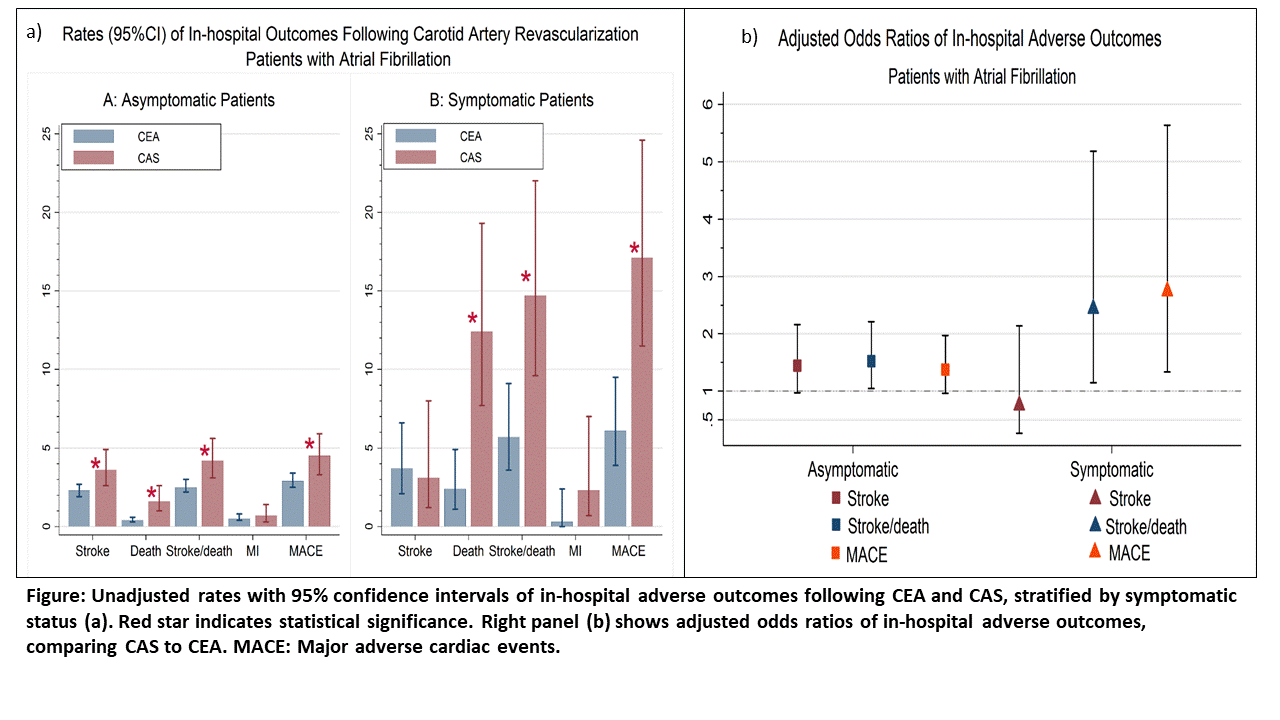Safety of Carotid Revascularization Procedures in Patients with Atrial Fibrillation
Besma Nejim, MBChB MPH1, Hanaa Dakour Aridi, MD1, Satinderjit Locham, MD1, Muhammad Faateh, MD1, Isibor Arhuidese, MD MPH2, Mahmoud B. Malas, MD MHS1.
1Johns Hopkins University School of Medicine, Baltimore, MD, USA, 2University of South Florida, Tampa, FL, USA.
Objectives: Atrial fibrillation (Afib) is a major contributor to cerebrovascular events. Coexisting carotid artery disease is not uncommon in Afib patients yet they are always excluded from major randomized clinical trials. Therefore, the aim of this study is to evaluate the safety of CEA and CAS in Afib patients.
Methods: The Premier Healthcare Database was inquired (2009-2015) and patients who underwent CEA or CAS with history of Afib on admission were captured via ICD-9-CM codes. Patients with concomitant cardiac intervention or trauma were excluded. Multivariable logistic modelling adjusting for patient demographics, comorbidities, use of statin, antiplatelet drugs, heparin/enoxaparin, warfarin, beta-blockers, and antiarrhythmic drugs was implemented to examine the risk of in-hospital stroke, stroke/death, and major adverse cardiac events (MACE) [composite of stroke, death, and/or myocardial infarction (MI)]. Analyses were stratified by symptomatic presentation.
Results: 7,176 patients were identified. Of those, 425 (5.9%) were symptomatic. Patients were similar in age, gender and race. Asymptomatic CAS patients exhibited worse comorbid profile than CEA patients (CHF, RF, CAD and COPD, all p≤.008). They were more likely to be on antiplatelet drugs (95.9%vs80.7%, p<.001), statin (69.3%vs66.1%, p=.041) but less likely to receive heparin/enoxaparin (82.3%vs90.8%) or antiarrhythmic drugs (23.6%vs32.5%, both p<.001). Baseline factors of symptomatic patients did not differ significantly. Stroke occurred in 2.3% and 3.6% in asymptomatic (p=.018) and in 3.7% and 3.1% in symptomatic (p=.752) patients following CEA and CAS, respectively. Stroke/Death rates were worse in CAS (asymptomatic: 4.2%vs2.5%, p=.004; symptomatic: 14.7%vs5.7%, p=.002, Figure1-a). Adjusted odds ratios for stroke did not vary based on procedure type regardless of
symptomatic status. However, mortality risk was significantly higher for CAS patients [asymptomatic aOR(95%CI): 3.71(1.92-7.18); symptomatic: 7.44(2.18- 25.39), p≤.001] so as stroke/death risk [asymptomatic: 1.52(1.05-2.21); symptomatic: 2.44(1.15-5.19), p≤.027]. MACE in symptomatic patient was 2.74 times higher in CAS than CEA [2.74(1.33-5.64), p=.006] (Figure1-b).
Conclusion: CEA was associated with lower periprocedural mortality and MACE risk in Afib patients compared to CAS. Symptomatic status in Afib patients seems to be associated with prohibitive mortality risk for both CEA and CAS. This underpins the role of screening in this particular population and the need to intervene before symptoms develop 
Back to 2018 ePosters




